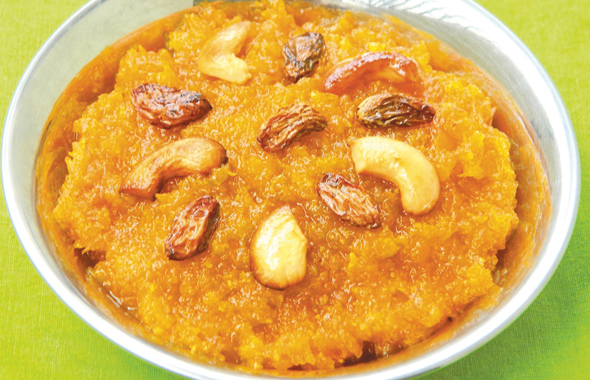Mama’s Punjabi Recipes – Pethe Da Halwa (Pumpkin Halwa)
When an Indian – especially a North Indian – thinks of petha (pumpkin), their first thought goes towards the famous white, crystallized petha of Agra where entire shops are devoted to various flavors of this sweet delicacy and not one street is without a pethawala. Agra petha is so well known and popular that when the Rajdhani Express train from New Delhi to Mumbai stops for only five minutes in nearby Mathura, people rush to the platform hawkers to buy boxes to give as gifts. Apart from the white Taj Mahal, a major export of Agra is its white petha!
Meanwhile, in other parts of North India, the yellow-orange petha of the plains is more common and known as kanshi phal, kashi or Sita phal in Hindi. Some consider this a very holy and pure vegetable because it is widely available in Uttar Pradesh where the holy city of Benares or Varanasi – also known as Kashi – is located. Actually, in Hindi kanshi phal means ash gourd or winter melon, which is cooling and both a laxative and a diuretic and is low in calories. Its juice has many medicinal properties.
In the Punjab, and in North India, petha is made into a sweetened halwa with lots of dried fruit and though some confectioners make it with pure butter to enhance its taste, it is most often made with vegetable oils and is delicious. The secret is to make sure that all the water that is released by the vegetable is completely dried up while it is cooked. Petha halwa tastes quite different from atta (flour) or suji (semolina) halwa.
Ingredients:
1 kg petha (pumpkin)
¼ cup bariq chinni (fine sugar)
½ cup olive oil or makhan (butter)
Handful of dried fruits of your choice
¼ tsp elachi powder (cardoman powder)
Directions:
1. Peel the petha, chop into small pieces and set aside.
2. Heat the oil in a kadai or wok and add the chopped petha. Stir well to coat and turn the heat down to medium. Cover and let the petha cook in its own steam till it is soft.
3. Check to see if it is soft and then mash well with a large spoon or spatula.
4. Now pour in the sugar and the petha will shed water and start to liquefy. Keep stirring to make sure the water evaporates.
5. When all the water is gone, turn the heat off. Add the dry fruit and mix thoroughly, and then sprinkle with the cardoman powder.
Shakuntla Malhotra is a skilled cook of Punjabi dishes made in the old-fashioned style that she learnt as a young woman in her ancestral home in Lyallpur, India before it became part of Pakistan after the Partition in 1947. People have often admired her cooking for its simplicity and taste that comes with each mouthful. Even in her mid-eighties, she continues to cook daily and agreed to share some of her delectable Punjabi recipes.
USE MUSTARD SEED OIL FOR TASTE AND MEDICINAL VALUE
In years gone by – and even now in many rural households – mustard seed oil was used exclusively in preparing dishes, and especially in making green mango pickles. Mustard seed oil has a distinctive yellow color and used to have a heavy, acrid smell, but this has gone away nowadays due to filtering and modern preparation techniques.
Mustard seed oil has medicinal qualities that make it good for reducing blood sugar, similar to eating kerelas (bitter gourds). A small dab of mustard is also used for cuts and skin conditions, and many Indian wrestlers smear themselves with it before fighting. The oil comes from the mustard greens which are left to ripen and the yellow seeds grow in big pods. The oil has come back into popularity and many dishes, like cauliflower, have a better flavor with it.


